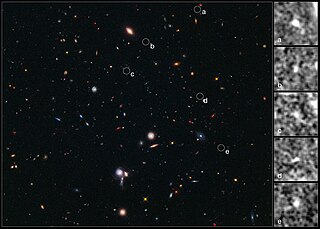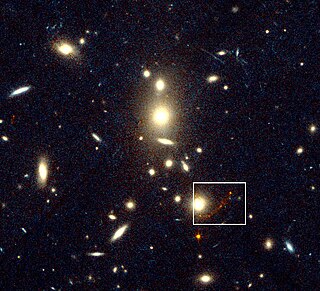
A quasar is an extremely luminous active galactic nucleus (AGN). It is sometimes known as a quasi-stellar object, abbreviated QSO. The emission from an AGN is powered by a supermassive black hole with a mass ranging from millions to tens of billions of solar masses, surrounded by a gaseous accretion disc. Gas in the disc falling towards the black hole heats up and releases energy in the form of electromagnetic radiation. The radiant energy of quasars is enormous; the most powerful quasars have luminosities thousands of times greater than that of a galaxy such as the Milky Way. Quasars are usually categorized as a subclass of the more general category of AGN. The redshifts of quasars are of cosmological origin.

A gravitational lens is matter, such as a cluster of galaxies or a point particle, that bends light from a distant source as it travels toward an observer. The amount of gravitational lensing is described by Albert Einstein's general theory of relativity. If light is treated as corpuscles travelling at the speed of light, Newtonian physics also predicts the bending of light, but only half of that predicted by general relativity.

A galaxy cluster, or a cluster of galaxies, is a structure that consists of anywhere from hundreds to thousands of galaxies that are bound together by gravity, with typical masses ranging from 1014 to 1015 solar masses. They are the second-largest known gravitationally bound structures in the universe after some superclusters (of which only one, the Shapley Supercluster, is known to be bound). They were believed to be the largest known structures in the universe until the 1980s, when superclusters were discovered. One of the key features of clusters is the intracluster medium (ICM). The ICM consists of heated gas between the galaxies and has a peak temperature between 2–15 keV that is dependent on the total mass of the cluster. Galaxy clusters should not be confused with galactic clusters (also known as open clusters), which are star clusters within galaxies, or with globular clusters, which typically orbit galaxies. Small aggregates of galaxies are referred to as galaxy groups rather than clusters of galaxies. The galaxy groups and clusters can themselves cluster together to form superclusters.

An Einstein ring, also known as an Einstein–Chwolson ring or Chwolson ring, is created when light from a galaxy or star passes by a massive object en route to the Earth. Due to gravitational lensing, the light is diverted, making it seem to come from different places. If source, lens, and observer are all in perfect alignment (syzygy), the light appears as a ring.

Halton Christian "Chip" Arp was an American astronomer. He is remembered for his 1966 book Atlas of Peculiar Galaxies, which catalogued unusual looking galaxies and presented their images.

The Twin Quasar, was discovered in 1979 and was the first identified gravitationally lensed double quasar, not to be confused with the first detection of light deflection in 1919. It is a quasar that appears as two images, a result from gravitational lensing caused by the galaxy YGKOW G1 that is located directly between Earth and the quasar.
Huchra's lens is the lensing galaxy of the Einstein Cross ; it is also called ZW 2237+030 or QSO 2237+0305 G. It exhibits the phenomenon of gravitational lensing that was postulated by Albert Einstein when he realized that gravity would be able to bend light and thus could have lens-like effects. The galaxy is named for astronomer John Huchra, a key member of the team that discovered it.

Gravitational microlensing is an astronomical phenomenon caused by the gravitational lens effect. It can be used to detect objects that range from the mass of a planet to the mass of a star, regardless of the light they emit. Typically, astronomers can only detect bright objects that emit much light (stars) or large objects that block background light. These objects make up only a minor portion of the mass of a galaxy. Microlensing allows the study of objects that emit little or no light.
John Peter Huchra was an American astronomer and professor. He was the Vice Provost for Research Policy at Harvard University and a Professor of Astronomy at the Center for Astrophysics | Harvard & Smithsonian. He was also a former chair of the United States National Committee for the International Astronomical Union. and past president of the American Astronomical Society.
A gravitational mirage or cosmic mirage is an optical phenomenon affecting the appearance of a distant star or galaxy, seen only through a telescope. It can take the form of a ring or rings partially or completely surrounding the object, a duplicate image adjacent to the object, or multiple duplicate images surrounding the object. Sometimes the direct view of the original object itself is dimmed or absent.

APM 08279+5255 is a very distant, broad absorption line quasar located in the constellation Lynx. It is magnified and split into multiple images by the gravitational lensing effect of a foreground galaxy through which its light passes. It appears to be a giant elliptical galaxy with a supermassive black hole and associated accretion disk. It possesses large regions of hot dust and molecular gas, as well as regions with starburst activity.

CL 1358+62 is a galaxy cluster located at z=0.33 redshift. Behind the cluster, lensed into a red arc is an infant galaxy that was the farthest object in the observable universe for a few months. It had a record redshift of z=4.92 and was discovered on July 31, 1997 by M. Franx and G. Illingsworth. It is located approximately 26 billion light years from Earth. Its redshift was measured by the Keck Telescope shortly after its discovery. Along with G1, another galaxy also lensed, was found to be at z=4.92. The pair of galaxies were the first things other than quasars to have the title of most distant object found, since the 1960s. The pair of galaxies remained the most distant objects known until the discovery of RD1 at z=5.34, the first object to exceed redshift 5.
CLASS B1359+154 is a quasar, or quasi-stellar object, that has a redshift of 3.235. A group of three foreground galaxies at a redshift of about 1 are behaving as gravitational lenses. The result is a rare example of a sixfold multiply imaged quasar.

Strong gravitational lensing is a gravitational lensing effect that is strong enough to produce multiple images, arcs, or Einstein rings. Generally, for strong lensing to occur, the projected lens mass density must be greater than the critical density, that is . For point-like background sources, there will be multiple images; for extended background emissions, there can be arcs or rings. Topologically, multiple image production is governed by the odd number theorem.
The Cloverleaf quasar is a bright, gravitationally lensed quasar.

J1000+0221 was the most distant gravitational lens galaxy known, and remains the most distant quad-image lens galaxy discovered so far. The measured distance the light has traveled, including the lensed deflection, is 9.4 billion light years. A very recent discovery by a group of astronomers led by Dr Arjen Van der Wel from the Max Planck Institute for Astronomy in Heidelberg, Germany, the results of which are accepted for publication on October 21, 2013 in the Astrophysical Journal Letters (arXiv.org). Using NASA’s Hubble Space Telescope, the astronomers discovered this quadruple gravitational lens dubbed J1000+0221 which would provide a further test for Einstein's theory of general relativity. These gravitational lenses also serve as light magnification tools that help astronomers to look at distant galaxies thus acting as a natural telescope.

SN Refsdal is the first detected multiply-lensed supernova, visible within the field of the galaxy cluster MACS J1149+2223. It was named after Norwegian astrophysicist Sjur Refsdal, who, in 1964, first proposed using time-delayed images from a lensed supernova to study the expansion of the universe. The observations were made using the Hubble Space Telescope.

Georges Meylan is a Swiss astronomer, born on July 31, 1950, in Lausanne, Switzerland. He was the director of the Laboratory of Astrophysics of the Swiss Federal Institute of Technology (EPFL) in Lausanne, Switzerland, and now a professor emeritus of astrophysics and cosmology at EPFL. He is still active in both research and teaching.

HE0435-1223 is a quadruple-lensed quasar and rare Einstein Cross located in the constellation Eridanus at a distance of approximately 2.33 billion light years away from Earth. HE 0435-1223 was discovered in October 2008 by astronomer Patrick Foley during a study and search for gravitational quadruple lenses in deep sky objects.













